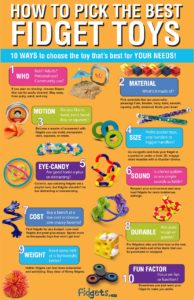Finding the Best Fidget Toy for YOU
Fidget Spinners have taken the world by storm, but I’m not sure they’re the best option for most people who might benefit from a fidget toy. I put together this “How to Pick the Best Fidget Toy” Infographic to help folks understand the options and select the best “tool” for their unique needs.
 Use these 10 variables to help you choose!
Use these 10 variables to help you choose!
Who
Consider who will be using the fidget toys. If it’s for a single person, then you can move on to the other variables. However, if it’s for communal use in meetings, workshops, or waiting rooms, you’ll want fidget toys that can be easily cleaned. Plastic items like Tangle and Snap and Click can easily be put into a dishwasher, whereas foam, putty, and sand are more difficult to clean.
Material
Fidget toys run the gamut when it comes to material. Wood, plastic, metal, rubber, stone, and latex components can create items that feel soft, squishy, hard, wiry, or malleable. The “softer” fidget toys, such as sand, clay or putty, fuzzy pipe cleaners, and squeezable balls like the air-filled Puffer Balls, and sand-filled Isoflex Balls lend themselves to squeezing and shaping. Beach-in-a-Box kinesthetic sand falls into this category too. Materials that are more firm are often manipulated in other ways, such as bending, flexing or twisting. Tangle, Klixx, and Magnetic Stones are great examples. In a class by itself is the KOOSH ball with its iconic rubbery strands offering a singularly unique feel.
Motion
Some are not drawn to a fidget toy because of the material, but rather the motion used to manipulate it. Consider what form of movement is most soothing — stretching, twisting, flexing, building, spinning, shaping, clicking, etc. When thinking about the motion required to manipulate a fidget toy, you will become aware that some are better suited for either one hand or two, while others are satisfying no matter how many hands you use. You will also find that some require the motion of just one finger (like pen clicking), rather than using more muscles. Fidget toys that let you build, mold or shape can stoke creativity and activate different areas of the brain in a way that simply clicking a pen would not do. Gyrobi, Loopeez and Jeliku, each move in a distinct fashion.
Size
Having a fidget that’s small in size can be a big issue. I’ve heard of many fidgeters who like to keep something in a pant pocket, so that it’s easily transported, indiscreet, and can be used without anyone seeing. Tutti from Fidgetland is a great example. Small fidget toys can also be ideal for one-handed use and finger-tip manipulation. However, the small items don’t always feel as good in your hand as ones that are larger and chunkier, which can both feel more substantial and engage more of your muscles and therefore more parts of the brain.
Appearance
Even though fidgeting is really a tactile experience, looks do seem to matter. Fidgeters are drawn to playful colors, looks, and shapes when choosing the perfect fidget toy. Because memory and recall have been shown to improve when more areas of the brain are activated, the additional stimulus created by the visual, auditory, and emotional experience of using a fidget toy is likely to have a positive impact.
Sound
Ideally, a fidget toy will be silent, but not all are. A pen clicking is not silent, nor is a Slinky, but they are still great fidget tools. Simply be aware that some may be louder and more distracting than others and ascertain whether your group is mature enough to control the sounds of their fidget toys or not.
Cost
Serious fidgeters are the least sensitive to cost and will not flinch at $10-$25 for a single item. If you’re looking to purchase one item for individual use, you will likely pay a premium for the right item. If you like variety or are buying for a classroom, meeting room, or team of people, you may have a stronger interest in keeping the individual price a little lower. Fidget toys generally run anywhere from $1.00 to $12.00, with the average being closer to $3.50.
- Durability – many tools that we use as fidgets were initially developed for the toy market. They are fairly inexpensive and if you try to break them, you probably will succeed. If it’s not strong enough to withstand a lot of repetitive motion, it shouldn’t be called a fidget toy! Still, you will find some variance in durability and washability. Hard plastic, wood, and metal are likely to stand the test of time longer than rubbery or gel-filled items, which pick up more dirt and are more difficult to clean.
- Weight – our fidget toy testers often prefer a little heft or weight. Of course, they can’t be too heavy or cumbersome, but those that are really light or flimsy are often found to be less appealing.
- Fun Factor – sometimes you just want a toy that will make you smile. The Cheese and Mice is a perfect example. It’s just plain, old fun!
Fidget toys come in literally dozens of colors, shapes, sizes, and materials. If you’re among the millions of people to have #fidgetfever, taking a bit of time to think about what features will suit your needs or the needs of your group can help you narrow your options. I encourage you to jump on the Fidget Cube bandwagon and support them through KickStarter AND start building your own collection of fidget toys, so that no matter what your mood, what you’re doing, or who you’re with, you have the perfect fidget to help you focus. Some great shops for fidget toys include: Trainers Warehouse, , Therapy Shoppe.
- +45
Comments


4 thoughts on “Finding the Best Fidget Toy for YOU”